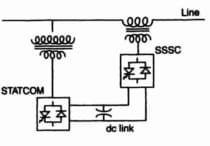Load Compensation
1. Load compensation is the management of __________ to improve the quality of supply in ac power systems.
a. Power Quality
b. Active power
c. Reactive power
d. Apparent power
2. Power-factor correction usually means the practice of generating reactive power as close as possible to the ________.
a. Source
b. Power plant
c. Load
d. Substation
3. Voltage regulation becomes an important and sometimes critical issue in the presence of loads which vary their demand for_________.
a. Active power
b. Reactive power
c. Lagging Power factor
d. Leading Power factor
4. The supply utility are bound to limit their supply voltage, typically _________ averaged over a period of a few minutes or hours.
a. ±5%
b. ±10%
c. ±15%
d. ±20%
- It is much more practical and economic to size the power system according to the maximum demand for real power, and to manage the reactive power by means of ‘compensators’ and other equipment which can be deployed more flexibly than generating units and which make no contribution to fault levels.
Loads Requiring Compensation
1. It is typical that for sizeable industrial loads, power-factor correction is economically advantageous if the uncompensated power factor is less than ________.
a. 0.5
b. 0.6
c. 0.7
d. 0.8
- Typical of loads requiring compensation are arc furnaces, induction furnaces, arc welders, induction welders, steel rolling mills, mine winders, very large motors (particularly those which start and stop frequently), opencast excavators, wood chip mills, and high-energy physics experiments (e.g., synchrotrons) which require pulsed high-power supplies.
2. Large motor starts, limits Permitted in Voltage Fluctuation is ________.
a. 1-3%
b. 1-5%
c. 5-10%
d. 2-5%
3. Mine hoists, excavators, steel rolling mills, large thyristor-fed dc drives have limits permitted in voltage fluctuation at distribution voltages is _____ and at transmission voltages is ______.
a. 1-3%, ½-1½%
b. 1-5%, ½-1½%
c. ½-1½%, 1-3%
d. ½-1½%, 1-5%
4. Limits Permitted in Voltage Fluctuation for Arc furnaces is __________.
a. ±15%
b. ±10%
c. ±5%
d. ±20%
*Do remember the Specification of a Load Compensator
*Kindly go through POWER-FACTOR CORRECTION AND VOLTAGE REGULATION IN SINGLE-PHASE SYSTEMS
Also read the difference between Before compensation and After compensation.
5. A purely reactive compensator cannot maintain both constant _______ and __________ simultaneously.
a. Current, unity power factor
b. Voltage, unity power factor
c. Current, 0.8 power factor
d. Voltage, 0.8 power factor
LOAD COMPENSATOR AS A VOLTAGE REGULATOR
1. The knee point voltage (𝑉𝑘)
2. The maximum or rated reactive power (𝑄𝛾𝑚𝑎𝑥)
3. The compensator gain (𝐾𝛾)
1. The compensator gain (𝐾𝛾)__________.
2. The voltage sensitivity for load reactive power is ____________.
Representation of Three-phase Delta Connected Unbalanced Load
A three-phase delta connected unbalanced and its equivalent star connected load are shown in fig.
The three-phase load is represented by line-line admittances
The delta connected load can be equivalently converted to star connected load using following expressions.
An Alternate Approach to Determine Phase Currents and Powers
Do remember this ,
Where,
- MCQs on FACTS Page 1
- MCQs on FACTS Page 2
- MCQs on FACTS Page 3
- MCQs on FACTS Page 4
- MCQs on FACTS Page 6
- MCQs on FACTS Page 7
- MCQs on FACTS Page 8













0 Comments
If you have any doubt, feel free to ask.